Instructions: A Visual Glossary of Six Stages of Nitrate Film Base Deterioration
Identification
Nitrate is difficult to distinguish from other film bases. Methods of identification include edge printing with “NITRATE” or “V” notch code in upper right corner (emulsion facing up), dating information, polarization (see POLARIZATION VIEWER), or destructive testing such as the diphenylamine test, the burn test and the float test).
Deterioration
- Deterioration of nitrate can be categorized into six stages.
- In general, until stage three deterioration, negatives will have legible photographic detail and can still be duplicated.
- Image legibility is decreased in the final fourth, fifth and sixth stages. Negatives at these stages should be digitized before the image fades away and placed in cold storage before further deterioration occurs, or destroyed.
- Deterioration may not be uniform across the image, so the stage of deterioration should be determined by assessing the worst area.
Stage 1
- Legible image
- No visible deterioration
Stage 2
- Legible image
- Some image fading possible
- Film support begins to yellow
- Emulsion has signs of silver mirroring
- Odor of nitric acid can be detected
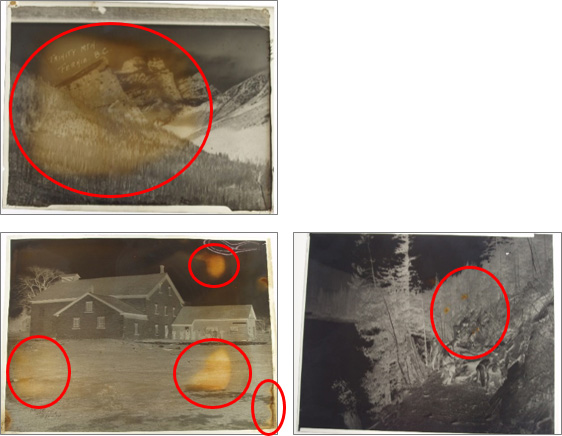
Non-uniform yellow deterioration
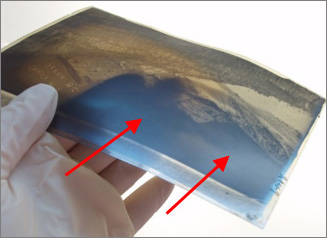
Silver mirroring on a nitrate negative will appear on the emulsion side
Stage 3
- Legible image
- Some image fading possible
- Film support turns yellow or becomes sticky
- Silver mirroring is present in the image layer
- Odor of nitric acid is present
- Curling

Severe curling (example 1), support turned yellow (example 2) and deterioration “halo” around the image on the emulsion side only (example 3)
Stage 4
- Partially legible image
- Image begins to fade
- Film support becomes amber in colour
- Silver mirroring
- Odor of nitric acid is present
- Nitric gas bubbles may be visible between the emulsion and the film support
- “Oil-slick” appearance on the emulsion side
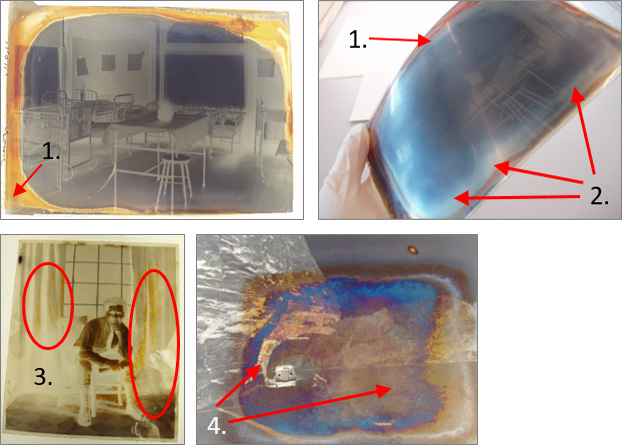
Deterioration around image border (example 1), silver mirroring (example 2), Uneven deterioration (example 3) and “Oil-slick” appearance on emulsion side (example 4)
Stage 5
- No legible image
- Film becomes soft
- Can adhere to adjacent items such as negatives or enclosures
- Silver mirroring
- Odor of nitric acid is strong
- Surface may be covered with sticky froth
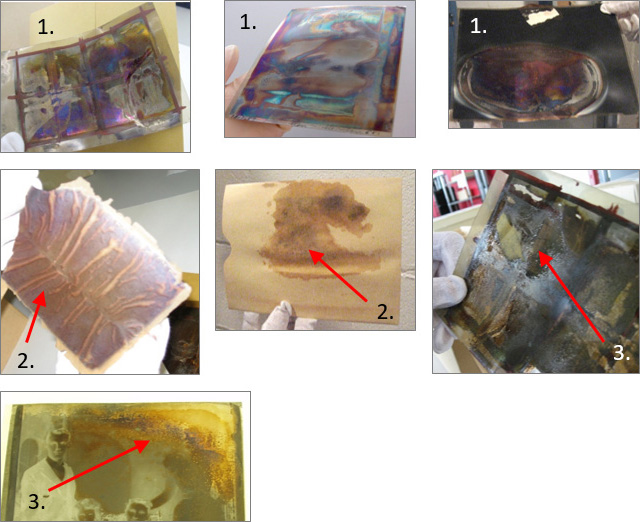
“Oil-slick” completely obscures image (example 1), sticky film adhering to enclosure (example 2), and sticky film and froth (example 3)
Stage 6
- No legible image
- Gives off a very strong odor of nitric acid
- Film degrades into a brown acid powder
- Film breaks or shatters easily
- Film in this stage of deterioration should be disposed of as hazardous waste
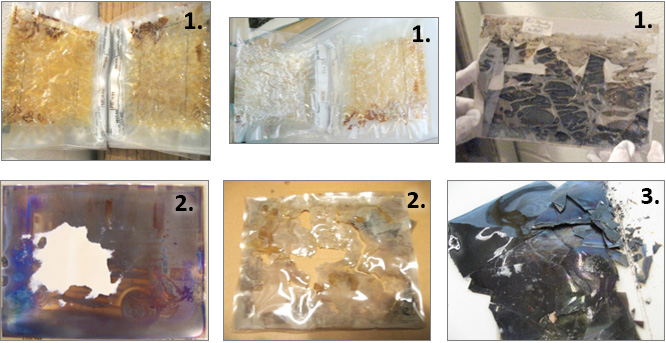
Adhesion to enclosures (example 1), breaks and shattering (example 2), and sheet film turning to dust (example 3)
Bibliography
Bennett, Karen L. and Jessica S. Johnson. “Identification of Film-Base Photographic Media,” National Parks Service Conserve O Gram, No. 14/9, 1999.
Fischer, Monique. “A Short Guide to Film-Based Photographic Materials: Identification, Care and Duplication,” NEDCC Technical Leaflet, updated 7/2012.
Valverde, María Fernanda. Photographic Negatives: Nature and Evolution of Processes, Rochester, New York: Advanced Residency Program in Photograph Conservation, 2005.
Acknowledgements
Tania Passafiume
Head Conservator of Photographic Materials
Carla Klück
Digitization Project Co-ordinator (acting)
Anna Lehn
English Editor
Special thanks to:
Janet Kepkiewicz, Chris Landry, Anne Macdonnell, Amanda Maloney and Ashley Stevens